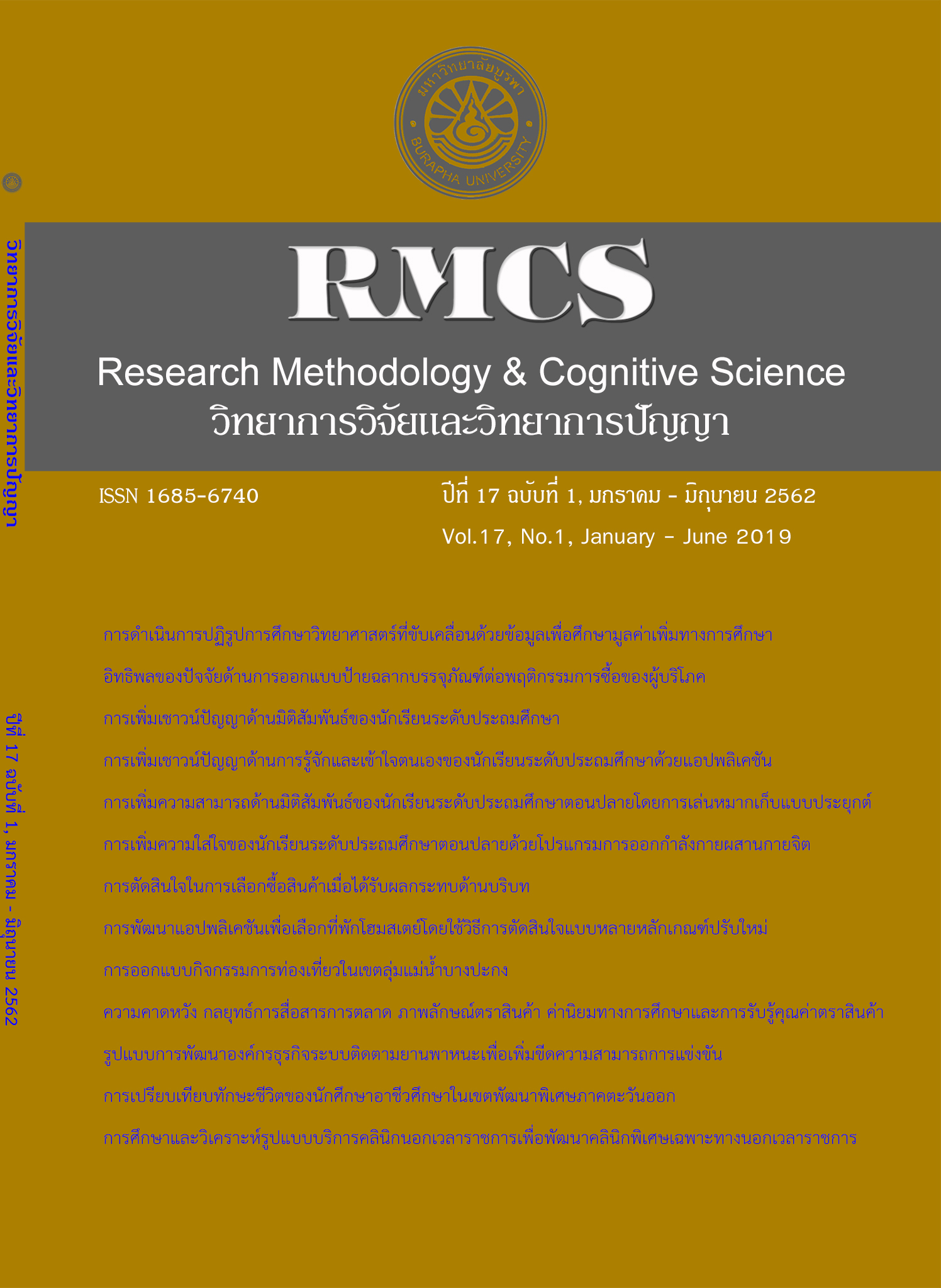Designing River Tourism Activities along The Bangpakong River
Main Article Content
Abstract
The research aimed to 1) Assess the potential of tourism activities along the Bangpakong River, 2) Develop the existing tourism activities, 3) Design new tourism activities, and 4) Create tourism activities plan along the Bangpakong River for the entire year. The research tools contain with 1) Tourism activities survey, 2) In-depth interview, 3) Tourism activities along the Bangpakong River assessment form, and 4) Tourist questionnaires. Developed and designed were implementing the design thinking process. The samples for the research were composed of 20 tourism location executives participating in the in-depth interview, 5 experts assessing the potential of tourism activities, 20 stakeholders brainstorming, 6 experts assessing the tourism activities prototypes, and 60 tourists providing tourism experiences and examining tourism activities. Content analyses, percentage and SWOT analysis were used to analyses the data. The result found that:
- Tourism activities along the Bangpakong River had the potential was in a middle level. MuangChachoengsao district had the highest potential. The potential was in a high level. The highest potential tourism activity was TaladBanmaiMuangPaedriw community tourism activity.
- In developing the existing tourism activities in the area of MuangChachoengsao district, cruising tourism activities could be enhanced to connect local tourist attractions and religious places in MuangChachoengsao district. The tourism activities could be develop the community’s way of living as well as its art and culture.
- In designing tourism activities in Bangpakong district, the events could be designed as activities on a bicycle route for community tourism, tourism activities following the community’s way of living, and the CSR tourism activities.
- The Bangpakong River could be developed and designed to provide tourism activities in combination with local traditional festival to attract tourists for the entire year.
Article Details
References
กระทรวงการท่องเที่ยวและกีฬา. (2550). คู่มือการตรวจประเมินมาตรฐานคุณภาพแหล่งท่องเที่ยวทางธรรมชาติ. เข้าถึงได้จากhttps://www.dot.go.th/ebooks/ ebooks-group/3
การท่องเที่ยวแห่งประเทศไทย. (2561). โครงการศึกษาพฤติกรรมนักท่องเที่ยวชาวไทยที่มีศักยภาพในการใช้จ่าย. กรุงเทพฯ: บริษัท แบรนด์ เมทริกซ์ รีเสิร์ช จำกัด.
สมบัติ กาญจนกิจ. (2560). นันทนาการและอุตสาหกรรมท่องเที่ยว (Recreation & Tourism Industry)(พิมพ์ครั้งที่ 3). กรุงเทพฯ: โรงพิมพ์แห่งจุฬาลงกรณ์มหาวิทยาลัย.
สำนักงานคณะกรรมการพัฒนาเศรษฐกิจและสังคมแห่งชาติ. (2559).สรุปรายงานการศึกษาโครงการสำรวจศักยภาพแหล่งท่องเที่ยวประเภทเกาะทั่วประเทศ เพื่อส่งเสริมพัฒนาให้เป็นแหล่งท่องเที่ยวที่มีคุณภาพของประเทศ.เข้าถึงได้จาก http://www.nesdb.go.th/ewt_news.php?nid=6140&filename=index
Aukerman, H. (2011). Water and Land Recreation Opportunity Spectrum (WALROS).Colorado: U.S. Department of the Interior.
Bowdin, G., Allen, J., O’Toole, W., Harris, R., & McDonnell, I. (2006). Event management (2nded.). Oxford: Elsevier.
Brown, T. (2008). Design thinking. Harvard Business Review, 86(6), 84-92.
Brown, T., & Wyatt, J. (2010). Design thinking for social innovation. DevelopmentOutreach, 12(1), 29-43.
Budruk, M., & Phillips, R. (2011). Quality-of-life community indicators of park, recreation and tourism. Dordrecht: Springer.
Dickman, S. (1996). Tourism: An introductory text (2nded.). Sydney: Hodder Education.
Getz, D., & Page, S. J. (2016). Progress and prospects for event tourism research. Tourism Management, 52(3), 593-631.
Graci, S., &Dodds, R. (2008). Why go green? The business case for environmental commitment in the Canadian hotel industry. An International Journal of Tourism & Hospitality Research, 19(2), 251–270.
Griffin, A., & Hauser, J. R. (1993). The voice of the customer. Marketing Science, 12(1), 1-27.
Jennings, G. (2009). Water-based tourism, sport, leisure, and recreation experiences. Routledge: Elsevier’s Science & Technology.
Joyce, A., &Paquin, R. L. (2016). The triple layered business model canvas: A tool to design more sustainable business models. Journal of Cleaner Production,135(2), 1474-1486.
Kumar, V. (2013). 101 Design methods a structured approach for driving innovation inyour organization. New Jersey: Wiley.
Osterwalder, A., &Pigneur, Y. (2010). Business model generation. New Jersey: John Wiley & Sons.
Pfister, R. E., & Tierney, P. T. (2009). Recreation, event, and tourism businesses: Start-up and sustainable operations. United States: Human Kinetics.
Piercy, N., & Giles, W. (1989). Making SWOT analysis work. Marketing Intelligence &Planning, 37(4), 5-7.
Pike, S., & Page, S. J. (2014). Destination marketing organizations and destinationmarketing: a narrative analysis of the literature. Tourism Management, 41(2), 202-227.
Prideaux, B., & Cooper, M. (2009). River tourism. Oxford: CAB International.
UNWTO. (2015). World tourism barometer volume 13 January. Retrieved from http://dtxtq4w60xqpw.cloudfront.net/sites/all/files/pdf/unwto_barom15_01_january_excerpt_1
World Tourism Organization. (2004).Indicators of sustainable development for tourism destinations: A guidebook. Madrid: WTO.
World Travel and Tourism Council. (2012).Travel and Tourism: Economic Impact, Madrid: UNWTO.
